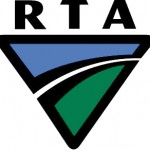RTA letting trucks destroy our Blue Mountains
Saturday, December 24th, 2011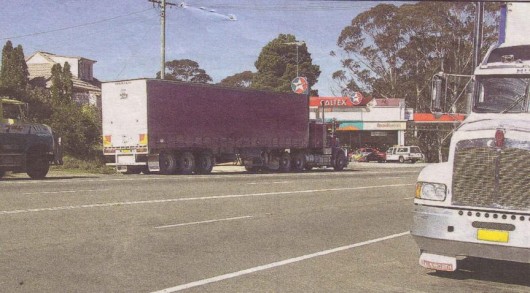 Noisy by day, nightmarish by night: Mt Victoria residents (Blue Mountains)
near this 24-hour Caltex service station are being disturbed round-the-clock
by truck drivers parking on their doorstops.
[Source: Blue Mountains Gazette, 20040924]
Noisy by day, nightmarish by night: Mt Victoria residents (Blue Mountains)
near this 24-hour Caltex service station are being disturbed round-the-clock
by truck drivers parking on their doorstops.
[Source: Blue Mountains Gazette, 20040924]
.
As alternating Labor and Liberal governments ignore rail investment across Australia and instead encourage and invest hundreds of million of our taxes in bigger roads for truck freight, regional highways are being transformed into noisy and dangerous trucking expressways.
Year on year, the regional Great Western Highway over the Blue Mountains for instance, has seen a steady increase in the number, size and frequency of trucks using it for long-distance linehaul. Produce, fuel, sand, soil, cement, grain, steel, concrete pipes, shipping containers are getting carted by road, some from as far away as Darwin and Perth, over the highway that runs through Blue Mountains towns and villages. There are many different speed zones to ensure the safety of local road users. All of these freight types could be carted by rail, which for the most part runs alongside the highway, but is mostly only used by passenger trains. The only commodity still banned is uranium but with federal Labor recently allowing uranium sales to India to resume, is it only matter of time before radioactive uranium is carted through Blue Mountains towns and villages?
There are commuters, school zones, buses, cyclists, pedestrian crossings and increasingly 19 metre B-double trucks hurtling along the same highway driven by ‘trip-rate’ pay incentives. Tail-gating is an all too frequently noted dangerous habit of many of these truck drivers, yet the NRMA suggests that “you try not to let the size of the vehicle intimidate you“. (Karen Fittall, NRMA’s ‘Open Road’ magazine, September/October 2005, ^http://www.mynrma.com.au/cps/rde/xchg/mynrma/hs.xsl/heavy_going.htm).
.
Trucks behaving badly Pacific Highway (and Great Western Highway)
.
.
Somehow the Transport Workers Union has allowed the hourly rate to go out the window in favour of the employer’s convenient fixed cost ‘trip rate’. So to a truck driver it’s more trips for more money based on commercial incentive arrangements. This incentive structure has become the motivation driving faster trucks and therefore more dangerous trucks to push and exceed speed limits. Across the Blue Mountains, both Great Western Highway and Bell Line of Road, highway signposted speed limits are systemically unenforced.
.
Where’s the speed governor? Where are the road patrols?
.
.
At the time of Bob Debus MP as NSW Labor Member for Blue Mountains (1981 – 1988, then again 1995 – 2007), then federal Labor member for Macquarie (2007 – 2009), the once prohibited B-double trucks surreptitiously started using the Great Western Highway. How was this allowed? Now 19 metre B-doubles are at such frequency along the highway as to be standard, but there has been no local community consultation nor local community approval. It has been an undemocratic impost. What is stopping 26 metre B-doubles creeping in?
.
Exhaust Brake Noise is Rife!
.
Many trucks drivers on the highway apply their noisy engine brakes (engine compression braking) because they are told it saves on the cost of brake pads. Engine brakes in heavy vehicles are auxiliary brakes installed as important backup safety braking to reduce the load on service brakes on a steep descent. But many truck drivers have then engaged automatically so they kick in as soon as the driver takes his foot of the accelerator pedal. (This Editor holds a Class ‘HC’ Heavy Vehicle Drivers Licence, so is aware of this lazy habit).
Many truck engine brakes are noisy and the ‘bark’ characteristic of the noise reverberates considerably at night. Truck drivers selfishly use these even as they drive through Blue Mountains towns and villages. So 24 hours a day, often in the wee small hours, these exhaust brakes can be heard reverberating for miles around, keeping many Blue Mountains residents awake.
The police do nothing – they say it’s not their job. The Roads and Traffic Authority (RTA) does nothing, except put up tokenistic signs – ‘Trucks – limit engine braking‘, which is flatly ignored and not enforced. The Blue Mountains Council does nothing – it say it’s not it’s job, even though it accepts operating as an agency for the RTA at Katoomba.
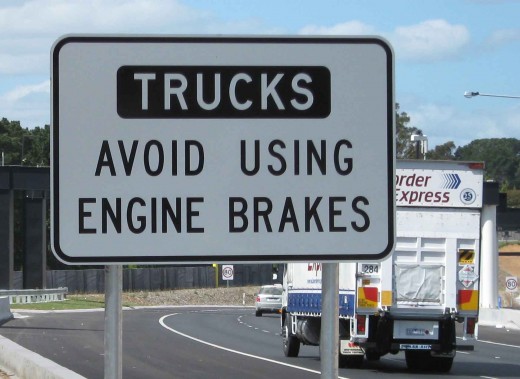 Possibly the most ignored sign on a highway
One sign means the RTA can avoid the cost of enforcement
while pretending to and meet its local government development guidelines
– on paper.
Possibly the most ignored sign on a highway
One sign means the RTA can avoid the cost of enforcement
while pretending to and meet its local government development guidelines
– on paper.
.
So truck owners apparently save on the cost of renewing their brakes, but selfishly at the expense of Blue Mountains residents trying to get a good night’s sleep. This editor lives a kilometre from the highway yet almost nightly hears some lousy trucker’s exhaust brakes as it moans up to the red lights outside Council chambers. Selfish bastards they are! I bet there’s been complaints, but typically none of these agencies has done squat about it.
.
Dodgy Truck Rest Area
.
Big linehaul trucks are destroying the Blue Mountains. Not only by their noise and dangerous speeds, but intimidating tail-gating to keep schedule and parking day and night outside residents homes.
At Mount Victoria in the Blue Mountains, the RTA and Blue Mountains Council approved of 24-hour Caltex Service Station and allowing truck drivers to use the adjacent highway shoulder to park and sleep. The shoulder was even widened to accommodate and encourage its use as a dodgy heavy vehicle rest area.
Since December 2003, Caltex at Mount Victoria was somehow allowed to become a round-the-clock operation with drivers of passing trucks, semi-trailers and B-doubles using the road shoulders to park their vehicles, often directly in front of residents’ front doors.
Local residents have complained to their members of parliament about the constant truck noise, of truck drivers leaving their rubbish by the side of the road and some even using front yards as a toilet – urinating and defecating!
In 2004, Liberal MP Duncan Gay, then Shadow Roads Minister, met with local community representatives at Mount Victoria, confirming that:
.
“The RTA, who are responsible for fatigue management need to provide proper rest points”
.
Now in 2011, with the Liberal Coalition in power, still nothing has been done. With speed being the main cause of at least half the recorded crashes, and the NRMA confirming a need for increased enforcement of heavy vehicle speed limits, Duncan Gay back in 2004 also advocated the installation of two new speed cameras ‘to convince motorists to take more care.’ Nup, not yet done either!
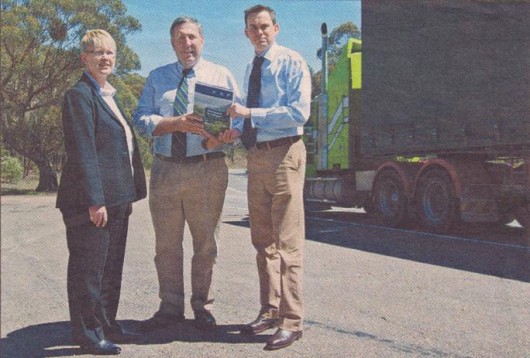 Then NSW Liberal Party Shadow Minster Duncan Gay (centre)
meeting Blue Mountains community representatives at Mount Victoria in 2004.
All care and no responsibility.
(Source: Blue Mountains Gazette)
Then NSW Liberal Party Shadow Minster Duncan Gay (centre)
meeting Blue Mountains community representatives at Mount Victoria in 2004.
All care and no responsibility.
(Source: Blue Mountains Gazette)
.
The RTA, while headlong enthusiastic about channelling hundreds of millions into capital works widening sections of the highway, highway maintenance and traffic enforcement has always been the RTA’s unsexy Cinderella. Fatigue is one of the biggest causes of crashes for heavy vehicle drivers and the RTA is the delegated authority responsible for overseeing heavy vehicle driver fatigue management on New South Wales roads. This necessarily includes providing for the necessary rest facilities.
Suitable rest areas are important for heavy vehicle drivers to take long and short rest breaks, use amenities and check loads and vehicles. Heavy vehicle drivers must conform to fatigue management legislation that specifies strict resting requirements. In order to fulfil these requirements they require suitable rest area facilities that are regularly spaced along key freight routes. (Source: ^http://www.rta.nsw.gov.au/heavyvehicles/safety/hvfatigue/index.html)
.
RTA reneging on its duty to provide suitable Rest Areas
On 29th September 2008, Australia’s National Transport Commission (NTC) introduced new Heavy Vehicle Driver Fatigue laws national-wide. This came about as a consequence of many crashes involving heavy vehicles on designated national freight routes and fatigue identified as a key cause. The Audit of Rest Areas against National Guidelines (Austroads 2006) had found that many rest areas on freight routes across Australia (many in NSW) were deficient in being suitable to provide for appropriate rest breaks to address driver fatigue. One of the key freight routes is Great Western Highway /Mitchell Highway (Nepean River to Dubbo).
The NTC Guidelines for Major Heavy Vehicle Rest Areas includes the following principles:
- Sites generally at no more than 100km intervals. Geographical and other physical constraints may require a range between 80 and 120km with the maximum limit generally being 120km.
- Sites are to be provided on both sides of the road on those parts of the network that have high levels of demand, while those with lower levels of demand will not require provision on both sides of the road.
- Sites are to be well signposted for heavy vehicle drivers and have suitable access for ingress and egress.
- Sites are to have designated hard stand parking for heavy vehicles and an appropriate number of parking spaces dependent on demand.
- Sites are to meet the basic needs of heavy vehicle drivers including provision of sealed pavements particularly for ingress and egress lanes/ramps, at least one toilet on each site, shade, shelter, rubbish bins and tables and chairs.
.
[Read More: ^http://www.ntc.gov.au/, access section under ‘Safety & Compliance’ tab].
The RTA restated these two years later in its public document ‘RTA Strategy for Major Heavy Vehicle Rest Areas on Key Rural Freight Routes in NSW, January 2010‘.
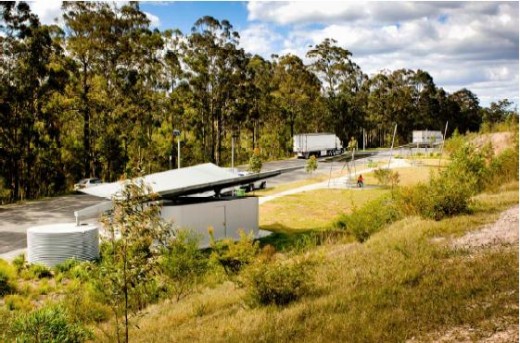 A RTA model heavy vehicle rest area
‘Station creek’ rest area north of Karuah, Pacific Highway, NSW
A RTA model heavy vehicle rest area
‘Station creek’ rest area north of Karuah, Pacific Highway, NSW
.
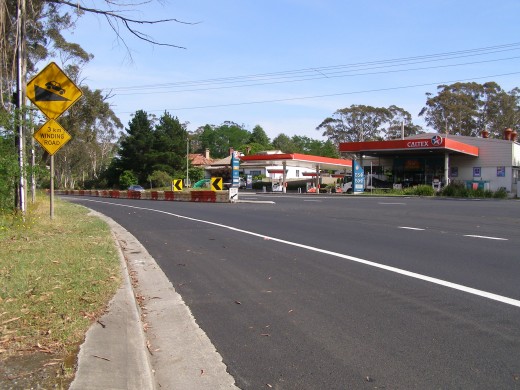 A RTA dodgy heavy vehicle rest area
‘Mount Victoria’ outside resident properties #45-47, #49, #51, #143, #147, #151.
.
A RTA dodgy heavy vehicle rest area
‘Mount Victoria’ outside resident properties #45-47, #49, #51, #143, #147, #151.
.
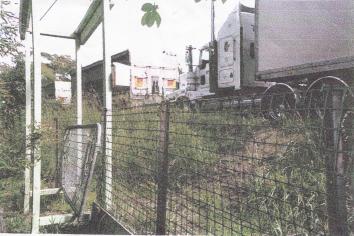 RTA dodgy (unconscionable) heavy vehicle rest area in front of residents’ homes
.
RTA dodgy (unconscionable) heavy vehicle rest area in front of residents’ homes
.
The RTA is obligated to provide for a Major Heavy Vehicle Rest Areas along the Great Western Highway accessible from each side of the highway at the intervals and with minimum standard of facilities as prescribed under the 2008 NTC Guidelines. Similarly, heavy vehicle drivers are required to have breaks at the frequencies, duration and under such conditions as prescribed under the 2008 Heavy Vehicle Driver Fatigue laws, basically to ensure that they ‘fit for duty’ and not too tired to drive safely. In NSW this is law under the Road Transport (General) Regulation 2005, which in relation to trucks applies to trucks with a Gross Vehicle Mass of 12 tonnes. Under the regulation, Basic Fatigue Management, starts with a solo driver required to have a 15 minute ‘stationary rest‘ after no more than 6 hours and 15 minutes at work, driving or otherwise. Longer work shifts have increasing rest break requirements. ‘Stationary rest‘ is defined as rest time that the driver spends out of the heavy vehicle or in an approved sleeper berth of a stationary regulated heavy vehicle.
.
However, along the Great Western Highway, which the RTA deems to be a ‘key rural freight route‘, the entire route of 200 km between outer Sydney (Penrith) and Orange provides no current rest area facilities, either westbound or eastbound that meet the 2008 NTC Guidelines. There should be two sites at no more than 100km apart, and on both sides of the highway, not just one side, with suitable access for ingress and egress. The sites should have stand parking for heavy vehicles and an appropriate number of parking spaces dependent on demand, as well as offering drivers a toilet, shade, shelter, rubbish bins and tables and chairs.
But the RTA simply doesn’t care. The RTA is prepared to ignore the problem of fatigue, to configure exemptions to avoid legalities and otherwise spend millions on the more politically sexy capital works upgrades. Three years after the NTC Guidelines, and many crashes later (involving heavy vehicles), the RTA has spent hundred of millions widening the Great Western Highway into a trucking expressway for bigger and more trucks to use, but has provided no facilities to address heavy vehicle driver fatigue. So the RTA is telling truck drivers to take proper breaks, but providing them with stuff all places to properly have a break. The RTA is negligent. It is also sly at claiming private enterprise facilities as its delivery of rest areas.
So the RTA is not just negligent. It is unethical.
No heavy vehicle facilities provide by the RTA for 200 km between Penrith and Orange
.
Along the Great Western Highway freight route between Penrith and Orange, a distance of over 200 km, the RTA provides no dedicated rest areas for heavy vehicles to the NTC Guidelines. The only RTA-built rest area is an unshaded paved vehicle check area just west of Faulconbridge with no facilities except two rubbish bins.
Only private enterprises are providing any form of adequate rest facility eastbound between Orange and Penrith that is accessible by heavy vehicles – the BP Service Station at Mount Lambie and the Caltex Service Station at Mount Victoria, but neither provide space for a heavy vehicle to park so the driver can sleep. The only heavy vehicle rest facility between westbound between Penrith and Orange is the Shell Service Station at Yetholm where there is ample off road parking, a roadside restaurant, toilets and an adjoining motor inn, but this is a commercial operation, not one provided by the RTA.
The RTA is thus contributory in culpability for heavy vehicle crashes due to driver fatigue along the Great Western Highway.
The RTA map below (which can be viewed full size by the link provided) shows the Great Western Highway from Penrith to Bathurst, with only two rest stops (‘Driver Reviver‘ sites in yellow) – one at Glenbrook (westbound only), and one at Faulconbridge (eastbound only). Neither are any more than roadside parking areas without facilities – big of the RTA!
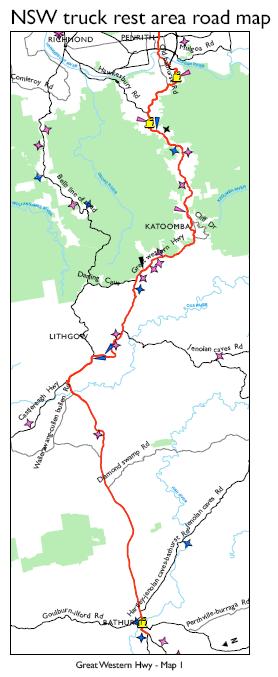 (View full size map with legend, click here)
(View full size map with legend, click here)
.
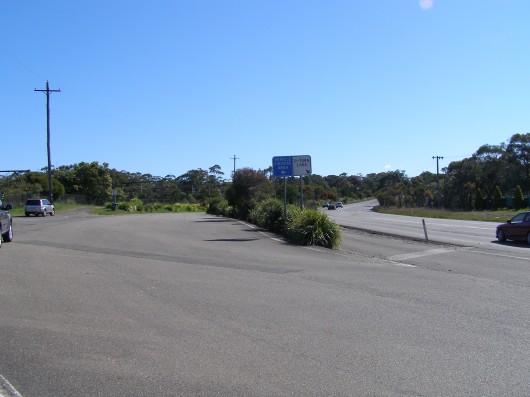 RTA’s key rural freight route supposed ‘rest area’
for Heavy Vehicles at Faulconbridge – westbound access only.
(Photo by Editor 20111019, free in public domain)
RTA’s key rural freight route supposed ‘rest area’
for Heavy Vehicles at Faulconbridge – westbound access only.
(Photo by Editor 20111019, free in public domain)
- No toilets
- No shade
- No shelter
- No tables
- Two bins, but who empties them and how often?
- Not signposted as ‘Rest Area’ but as ‘Vehicle Checking Area’ I wonder why? (see next zoom photo)
.
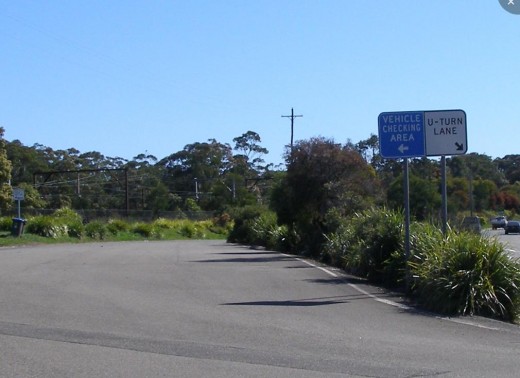 RTA key rural freight route truck stop Faulconbridge
Not signposted as ‘Rest Area‘ but as ‘Vehicle Checking Area‘
RTA key rural freight route truck stop Faulconbridge
Not signposted as ‘Rest Area‘ but as ‘Vehicle Checking Area‘
.
Back to the January 2010 ‘RTA Strategy for Major Heavy Vehicle Rest Areas on Key Rural Freight Routes in NSW’, the RTA lists the facilities available or not available for heavy vehicle drivers along the Great Western Highway between Penrith and Orange in two tables – one Westbound (p.19), one Eastbound (p.20).
Read ‘RTA Strategy for Major Heavy Vehicle Rest Areas on Key Rural Freight Routes in NSW, January 2010‘.
.
Westbound (south side of highway)
.
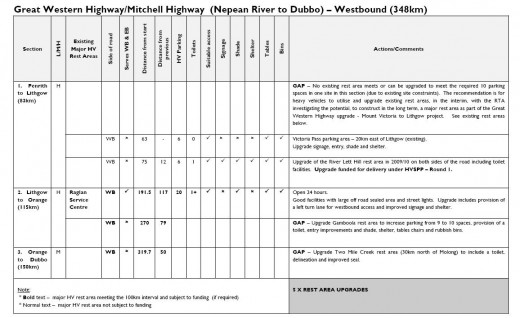 (Click to enlarge table)
(Click to enlarge table)
.
RTA Official Excuse:
‘Victoria Pass Parking Area‘ is nothing but a widened road shoulder outside the Caltex Service Station at Mount Victoria outside residents homes. There is no shade or shelter. The Caltex Service Station provides for refuelling/vehicle inspection, but no place for drivers to sleep in the vehicles.
At the time of writing, there are no current facilities at River Lett Hill – the statement of there being ‘a rest area…on both sides of the road including a toilet‘ is false and misleading.
At the time of writing, the Raglan Service Centre (Shell) is currently closed and is under construction as a BP service station. It is to be a private facility, not provided by the RTA.
RTA: “No existing rest area meets or can be upgraded to meet the required 10 parking spaces in one site in this section (due to existing site constraints). The recommendation is for heavy vehicles to utilise and upgrade existing rest areas, in the interim, with the RTA investigating the potential, to construct in the long term, a major rest area as part of the Great Western Highway upgrade – Mount Victoria to Lithgow project.”
Ed: Given this will cost about $1 billion, it is unlikely to be funded or built any time soon, and so is a poor excuse by the RTA for doing nothing.
.
Eastbound (north side of the highway)
.
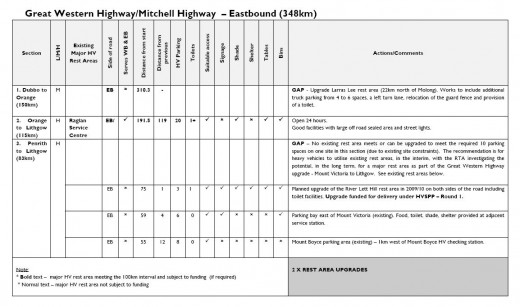 (Click to enlarge table)
(Click to enlarge table)
.
There is no heavy vehicle facility between Orange and Bathurst. The RTA’s mention of upgrading the Larra Lee rest area is a proposal only, just to fill in space in the table to mask its failure to provide a facility.
‘Raglan Service Centre’
At the time of writing the ‘Raglan Service Centre is closed. It was a Shell Service Station for heavy vehicles. It is currently under construction as a BP Service Station, but it is not a facilty provided by the RTA. The RTA’s branding of this facility as a ‘Raglan Service Centre’ is deceptive and misleading.
.
Caltex Service Station at Mount Victoria
The only facility that the RTA mentions is “Parking bay east of Mount Victoria (existing). Food, toilet, shade, shelter provided at adjacent service station“.
This false and misleading. The facilities are not that of the RTA. The only service offered by the Caltex Service Station for heavy vehicles is refueling, vehicle inspection, a roadside cafe and toilet. There is no shade or shelter either on the Caltex site or along the road shoulders. The “parking bay” is the road shoulder. What a deceptive fabrication!
.
RTA’s excuse for perpetuating its Dodgy Rest Area at Mount Victoria
.
Standard Politic Tactic #1: Blame lack of Federal Government – will sit well with NSW Roads and Transport Minister of the day
.
RTA:
‘Implementation of the RTA’s Strategy for Major Heavy Vehicle Rest Areas on Key Rural Freight Routes in NSW is largely dependent on the availability of funding from the Federal Government.
The Federal Government’s 2008/09 Budget outlined that the Department of Infrastructure, Transport, Regional Development and Local Government would provide $70 million across Australia over four years to fund a range of heavy vehicle safety initiatives. This funding is being allocated under the Heavy Vehicle Safety and Productivity Program (HVSPP) in two rounds with Round 1 covering 2008/09 – 2009/10 (complete) and Round 2 covering 2010/11 and 2011/12 (current). Under the HVSPP Guidelines a key consideration in allocating the funding is the extent to which state and territory governments commit to match the Federal Government’s funding contribution.
As part of Round 1 of the HVSPP, on 8 May 2009 the Federal Minister for Infrastructure, Transport, Regional Development and Local Government and the then State Minister for Roads announced $16M (50% Federal and 50% State) for NSW. Of this, $15M is currently being spent on 6 new rest areas and 22 rest area upgrades with the balance on bridge assessments for higher masses. In Round 1, NSW received 26.6% of $30 million available.
In applying the principles set in the RTA’s Guidelines for Provision of Major Heavy Vehicle Rest Areas a summary of needs across key rural freight routes in NSW is outlined in Table 2. Currently, on these routes 101 rest areas qualify as major heavy vehicle rest areas and 76 sites have been identified for enhancement. A total of 61 existing rest areas have been identified for upgrade to qualify as a major heavy vehicle rest area and 15 sites identified for new heavy vehicle rest areas. The strategic cost ($2009) to undertake required works that are not anticipated to be delivered as part of a major infrastructure proposal is estimated at around $50 to 60 million.
Delivery of works at all 76 identified sites is significantly higher than this strategic estimate.’
.
So what is the RTA’s ultimate excuse:
‘The RTA investigating the potential, in the long term, for a major rest area as part of the Great Western Highway upgrade – Mount Victoria to Lithgow.‘ . (Ed: Given the $1 billion pre-blowout estimate, the RTA can focus on its more sexy capital works highway upgrades)..Meanwhile, back at sleepless Mount Victoria, the Blue Mountains Council was told that the real estate profession had refused to place a valuation on the homes because of the problem and that the homes had been ‘effectively rendered worthless‘.
.
[Source: ‘Mt Vic’s truck dilemma’, by Len Ashworth, Lithgow Mercury, Tuesday 20081125].
